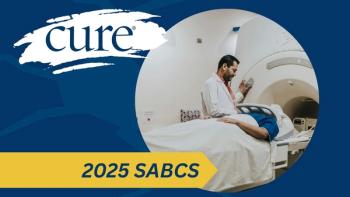
Expert Talks the Future in Metastatic Lung Cancer Treatment
The treatment paradigm for patients with advanced non-small cell lung cancer (NSCLC) is changing, as more emphasis is being placed on drug combinations and biomarkers, says Roy S. Herbst, M.D., Ph.D.
Roy Herbst, MD, PhD
The treatment paradigm for patients with advanced non-small cell lung cancer (NSCLC) is changing, as more emphasis is being placed on drug combinations and biomarkers, says Roy S. Herbst, M.D., Ph.D.
The immune checkpoint inhibitors have already disrupted the treatment landscape for patients with metastatic NSCLC, and these agents are now being examined for patients with brain metastases, a group traditionally excluded from clinical trials. Moreover, studies are looking to improve patient selection and personalization of care through biomarker discovery.
"As we look toward 2020, we're going to start using immunotherapy in patients with brain metastases," said Herbst, chief of Medical Oncology, Yale Cancer Center and Smilow Cancer Hospital. "Some patients do fairly well and it would be great if we could understand who those patients are but the other 80 plus percent don't do well. We need better biomarkers than PD-L1."
Several immune checkpoint inhibitors have gained approval for the treatment of NSCLC. In the second-line setting, Opdivo (nivolumab) is approved based on findings from the CheckMate 017 and 057 trials. Keytruda (pembrolizumab) is approved for tumors with PD-L1 expression on at least 1 percent of cells, based on findings from KEYNOTE-010. Additionally, Tecentriq (atezolizumab) has gained approval based on findings from the OAK trial.
In the second-line setting, where these agents were initially indicated, similar findings were demonstrated across each of the phase 3 pivotal trials. Response rates ranged from 14 percent to 20 percent with the immunotherapies compared with 9 percent to 13 percent for docetaxel. Moreover, there was approximately a 30 percent reduction in the risk of death with checkpoint inhibition compared with chemotherapy.
Findings in the frontline setting, however, were less congruent. In those with at least 50 percent PD-L1 expression on tumor cells, Keytruda demonstrated a 40 percent reduction in the risk of death compared with chemotherapy. However, in the CheckMate 026 study of those with PD-L1 expression on ≥1 percent of cells, Opdivo failed to show an improvement in progression-free survival (PFS) and overall survival (OS) versus docetaxel.
Other confounding frontline reports have also recently been announced, specifically topline findings from the MYSTIC trial, which highlighted a lack of efficacy for the combination of Imfinzi (durvalumab) alone or in combination with tremelimumab for patients with NSCLC with at least 25 percent PD-L1 expression. In this phase 3 trial, the combination failed to outperform standard platinum-based chemotherapy.
Joining these mixed results were findings for the combination of Keytruda and chemotherapy in the frontline setting, which led to an FDA approval in May 2017. The 12-month PFS rate was 56 percent in the Keytruda arm compared with 34 percent with chemotherapy alone, representing a 50 percent reduction in the risk of progression or death. However, OS was not significantly improved.
"For patients without mutation addicted cancer, the only way to improve survival is to get the patient an immunotherapy as soon as possible," Herbst said. "Certainly, if someone has PD-L1 expression in greater than 50 percent, they can get PD-1 alone. But, if someone is in that 0 percent to 50 percent range for PD-L1, you can look for a clinical trial but if not a trial the combination [of pembrolizumab and chemotherapy] is a reasonable option."
Following on the discordant results in the frontline setting, biomarkers are urgently needed to help select the best treatments, Herbst noted. To this end, biomarker development is currently under way to better understand markers for both sensitivity and resistance to checkpoint inhibition, he noted.
At this point, the only FDA-approved biomarker for the checkpoint inhibitors has been PD-L1, which is primarily localized to macrophages, dendritic cells, and T cells but not B cells. To further explore other markers, researchers looked at profiles of non-responders. In most cases, those who progressed failed to show upregulation of PD-L1 or any evidence of activated T cells.
Further studies were completed using pre- and post-treatment biopsies, which identified several T-cell markers to help further characterize potential responders. From this, four categories of tumors were identified, based on the presence of PD-L1 and tumor infiltrating lymphocytes (TILs). These subclasses were further characterized into 3 types based on pre-treatment biopsies and a test was developed, Herbst noted.
For the new diagnostic, type 1 tumors were characterized by low CD3 levels, representing a non-immunogenic tumor. Type 2 had high CD3 levels and low granzyme B (GZB) and Ki-67 expression, suggesting a dormant state. Type 3 was characterized by high CD3 and high GZB and Ki-67. Originally, the type 3 group was theorized to be the most active, although early findings favored those with type 2 tumors, according to Herbst.
In an initial examination that included 39 patients, those with type 1 (19 patients) and type 3 (13 patients) tumors showed similar results: both groups had a PFS probability below 40 percent at one year. For the type 2 group (seven patients), the PFS probability was 80 percent at one year and remained consistent out to three years of follow up. The OS probability at 18 months was 30 percent for type 3, approximately 50 percent for type 1 and 100 percent for type 3 tumors.
Based on these observations, a new diagnostic is currently being validated for commercial use to help select patients for immunotherapy, Herbst noted. Additionally, other efforts are looking to uncover a mechanism of acquired resistance to immunotherapies. In some cases of acquired resistance to checkpoint inhibitors, loss of beta 2 microglobulin (B2M) has been observed, Herbst noted. Following B2M loss, impaired antigen presentation is common, supporting the rationale for this biomarker. Further studies are examining this marker.
"We're really at a crossroads, with targeted therapies and immunotherapies. There are a lot of agents," said Herbst. "There are so many compounds, so many patients, and so many trials. It is going to be up to [oncologists and researchers] to run clinical trials, to continue to put patients on these studies, to get pre- and post-biopsies, and to do studies like Lung-MAP. This will be critical to the future."





